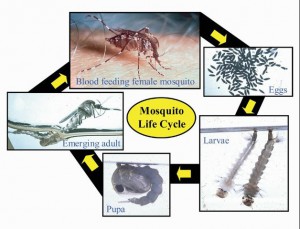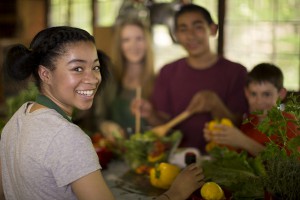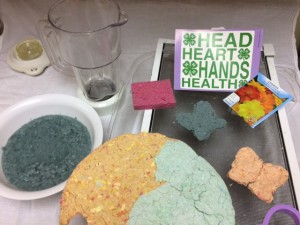by ewestbrook | Feb 26, 2016
 It’s February in Florida and as the weather gets warmer we Floridians start to turn our attention to the thousands of outdoor activities our beautiful state has to offer. Florida is not just known for its natural beauty, it is also known for it abundance of mosquitoes. With the mosquito transmitted Zika virus making headline news and the tell tale itchy red bites popping up on our unprotected skin you may be wondering what you can do to protect your family in the coming months. Millions of dollars are spent in Florida every year to combat mosquitoes. Municipalities will often spray for mosquitoes and use larvacides in wetland areas to control the pests. You can make a big difference in the effort to combat the blood-sucking parasites and prevent disease transmission by following the five d’s of mosquito control and prevention.
It’s February in Florida and as the weather gets warmer we Floridians start to turn our attention to the thousands of outdoor activities our beautiful state has to offer. Florida is not just known for its natural beauty, it is also known for it abundance of mosquitoes. With the mosquito transmitted Zika virus making headline news and the tell tale itchy red bites popping up on our unprotected skin you may be wondering what you can do to protect your family in the coming months. Millions of dollars are spent in Florida every year to combat mosquitoes. Municipalities will often spray for mosquitoes and use larvacides in wetland areas to control the pests. You can make a big difference in the effort to combat the blood-sucking parasites and prevent disease transmission by following the five d’s of mosquito control and prevention.

Larval mosquitoes in a pool of water
- Dump- Mosquitos spend the beginning of their lives developing in aquatic environments and they don’t mind small spaces. By periodically dumping standing water you can prevent them from growing into adults that feed on you. Standing water in old tires, plant containers, buckets and any other containers with standing water all provide a great environment for many species of mosquitoes to develop. By being vigilant in dumping these containers you are doing a lot to control mosquito populations.
- Drain– Kiddy pools, water troughs, pet water dishes and birdbaths all provide an ideal environment for mosquito larva to grow. You can prevent this by regularly draining and refilling these water sources.
- Dress– When you are dressing to go outdoors in the warmer months in Florida prepare for mosquitoes. Wear clothing that covers as much skin as possible to prevent bites. Long pants and long sleeve shirts made out of lighter materials like linen are ideal in our hot summer climate when venturing into the great outdoors. Also consider hats with mosquito netting
- DEET- Use an insect repellent that lists DEET or alternatively eucalyptus oil to prevent mosquito bites. DEET is proven to be the most effective repellent and safe for human use. Bug zappers, candles and ultra- sonic devices are not effective mosquito control measures. Save your money and invest in proven solutions like DEET based insect repellents.
- Dusk/Dawn- Mosquitoes are most active during the early morning and evening hours. Try to stay indoors during these time periods and if that is not possible make sure you are dressed to prevent mosquito bites and using DEET based insect repellent.

The mosquito lifecycle
For more information on mosquitoes in Florida call you county UF|IFAS Extension Office or county health department and check out these in-depth articles on the subject:
http://mosquito.ifas.ufl.edu/Fact_Sheets.htm
https://edis.ifas.ufl.edu/in851
http://edis.ifas.ufl.edu/in652
Do you have a love for the outdoors? Would you like to share your passion for the environment with the next generation of Florida citizens? If so, consider becoming a 4-H volunteer. Florida 4-H offers a range of opportunities for volunteers to teach youth about natural resources, shooting sports, and water conservation (just to name a few). For more information about becoming a 4-H volunteer, visit your local UF IFAS County Extension office or http://florida4h.org/volunteers.
by Jenny Savely | Feb 19, 2016

By 2050, the United Nations estimates that the total population will total around 9 billion people globally (United Nations: 2004). Meeting the challenge of addressing the needs of so many people is an opportunity for growth that can be gained through scientific developments and personal responsibility, areas in which 4-H eagerly works to educate youth and adults.
We learn that our everyday behaviors, even if they seem very small, can actually put a lot of strain on our environment when so many people do the same things.
We often ask our youth, “If everyone were to do the same things you do every day, what would that look like? What kind of impact do you think it would have?”.
We know that much of our daily energy use, like the amount of water we use, how much trash we produce, the kind of food we buy and where we buy it, and how much energy we use in our transportation, for example, can make a big difference if we all make decisions that keep our environment in mind.
We can help prevent environmental damage that leads to climate change and human illness by conserving energy and making a smaller ecological footprint. An ecological footprint is the amount of resources from the environment that are required to meet the demands of our everyday consumption of goods. 4-H encourages youth to make thoughtful decisions about their behaviors such as:
- Eating locally grown and in season produce
- Using reusable bags for shopping
- Buying products with less packaging and that are less processed
- Turning lights off when they aren’t in use
- Doing outdoor rather than indoor activities
- Walking, biking, carpooling, or taking public transportation
- Recycling
- Conserving water when brushing teeth and by displacing water in toilet tanks
- Only running washing machines with full loads
However, motivating people to change their behaviors can be difficult. In 4-H we work to encourage young people to understand at an early age the enormous impact they have on the health and well-being of others. The World Health Organization tells us that “…environmental factors are a root cause of a significant burden of death, disease and disability – particularly in developing (poor) countries. The resulting impacts are estimated to cause about 25% of death and disease globally, reaching nearly 35% in regions such as sub-Saharan Africa.” (World Health Organization: 2016). A good portion of environmental damage that affects us in negative ways is caused by our using more resources than our planet has the ability to renew at the same rate we use them and by extracting our resources in harmful ways. This may seem overwhelming, but there are actually very simple things that each of us can do that can significantly help lessen the impact. Actually, when we change our behavior is western countries like the United States, we can make more significant differences since we are one of the primary consumers of energy in the world.
And as always, youth learn not only by DOING but by helping to teach others! We encourage our youth to educate their friends and family as well as to mentor younger 4-H’ers in project areas like environmental science. If your youth or club is interested in learning more about energy conservation and environmental science projects, there are an array of wonderful resources, listed below, to help get you started. Your county 4-H agent is happy to help any youth or volunteer interested in this or any one of the project areas that help provide youth with research based education.
Games: http://www.energystar.gov/index.cfm?c=kids.kids_index
Curriculum: http://www.chesapeakebay.net/channel_files/18256/handout_-_4-h_environmental_curriculum.pdf
http://www.need.org/files/curriculum/guides/Saving%20Energy%20Student%20Guide.pdf
Resources for teachers: http://www.eia.gov/kids/energy.cfm?page=6
http://www.eia.gov/kids/energy.cfm?page=1
http://coseenow.net/antarctica/
United Nations. 2004. “World Population to 2300”. United Nations Department of Economic and Social Affairs: Population Division. United Nations: New York, NY.
World Health Organization: The Health and Environment Linkages Initiative (HELI). 2016. “Environment and Health in Developing Countries”. URL http://www.who.int/heli/risks/ehindevcoun/en/index1.html. Accessed February 5, 2016.
Photo: Wake County, North Carolina 4-H. http://www.wakegov.com/humanservices/family/4h/traditional/Pages/default.aspx
by Monica Brinkley | Feb 12, 2016

Making family meal time a priority can increase your children’s self esteem.
In a recent book entitled The Surprising Power of Family Meals, author Miriam Weinstein asks this question:
“What if I told you that there was a magic bullet-something that would improve the quality of your daily life, your children’s chances of success in the world, (and) your family’s health…? Something that is inexpensive, simple to produce, and within the reach of pretty much everyone? (Weinstein, 2005, p. 1)”
You guessed it, that magic bullet is the family meal! According to research, eating together as a family on a regular basis has some surprising effects. When sharing a meal together family bonds become stronger, children are better adjusted, family members eat more nutritional meals, they are less likely to be overweight, and they are less likely to abuse alcohol or other drugs. Given the positive benefits of eating together, why are more families not doing it?
It may come as a surprise to you that 71% of older children and teenagers consider talking/catching-up, and spending time with family members as the best part of family dinners. Family meals are a representation of the ethnic, cultural, or religious heritage of the family (Weinstein, 2005). A study found that children who knew a lot about their family history had a closer relationship to family members, higher self-esteem, and a great sense of control over their own lives (Duke, Fivush, Lazarus, & Bohanek, 2003).
With this in mind, why not make shared family meals a priority. Emphasize the importance of being together, not creating an elaborate meal that everyone will enjoy. Set regular meal times by writing them on the calendar. Let everyone know when dinner is served and when they must be home.
If the family is not used to eating together regularly, start small. At first, get used to eating together by scheduling family meals two or three days per week. Then, as the weeks progress, begin to have more and more regular meals.
Make family meals fun. Include children in the preparation of the meal and in the decision about what foods will be offered during the meal. Of course, parents have final say about what foods are prepared, but allowing the children to participate can create a fun environment.
- Keep a sense of humor while at the dinner table.
- Eliminate distractions, like TV, telephone, and cell phones.
- Limit conversations to positive or neutral topics.
- Be a good role model. Show children good etiquette and table manners.
Eating together as a family is more than just a meal, it is an opportunity for families to come together regularly in support of family unity. Although there is no guarantee that eating together as a family will resolve all family problems, it may provide the opportunity to make a fresh start. Do you have a passion for meal preparation or etiquette that you would like to share with the next generation? Consider becoming a 4-H Volunteer! Visit our website or contact your local UF IFAS Extension Office.
For the more information on this topics please visit the EDIA website at http://edis.ifas.ufl.edu, FCS8871.
Source Family Nutrition: The Truth about Family Meals, Larry Forthun
by pmdavis | Feb 5, 2016

Grow Card Supplies and products
4-H literally got its start with gardening. The very first 4-H Clubs focused on growing tomatoes and corn for boys and canning for girls. Many youth and volunteers still enjoy gardening projects today. One great curricula that is used is the Junior Master Gardening Program. This program allows youth to enhance their life using gardening as the spark of interest. Gardening enriches youth’s lives, promotes good health, gives a sense of environmental awareness and saves money.
One of the activities I enjoy doing with youth combines gardening with recycling and crafting. As a group we will make our own paper grow cards or ornaments that have seeds embedded in them. Once the cards are dry, we deliver them as a service project. The cards are fun and inexpensive to make and are a perfect activity for your next club meeting! Try making them as valentines for Valentines Day. For beginners, we recommend growing tomatoes, lettuce, peppers, cucumbers, basil, chives, or parsley. Not into vegies? Try starting marigolds, cosmos, sunflowers, zinnias, pansies, or petunias.
Download our detailed factsheet with photos and directions. This activity is great for any occasion when you need a card or small gift. You can use as party favors by making them into ornaments using raffia to hang them from a tree or gift bag. You can take them to a nursing home, veterans center, hospital or other site as a service project for your club. Just be sure to share with the individual that they need to plant your card or ornament. It is a great way to help youth share their joy of gardening with others.
Other Extension gardening resources include:
• Florida Vegetable Gardening Guide
If you have a green thumb, consider going “totally green” as a 4-H gardening volunteer! 4-H needs caring adults like you to share their knowledge and passion for gardening with the next generation. Through the 4-H gardening project, youth not only learn gardening knowledge and skills, they also learn responsibility, teamwork, and other life skills that will help them grow up to be compassionate and competent citizens. To get involved, contact your local UF IFAS Extension Office, or visit Florida 4-H.
 It’s February in Florida and as the weather gets warmer we Floridians start to turn our attention to the thousands of outdoor activities our beautiful state has to offer. Florida is not just known for its natural beauty, it is also known for it abundance of mosquitoes. With the mosquito transmitted Zika virus making headline news and the tell tale itchy red bites popping up on our unprotected skin you may be wondering what you can do to protect your family in the coming months. Millions of dollars are spent in Florida every year to combat mosquitoes. Municipalities will often spray for mosquitoes and use larvacides in wetland areas to control the pests. You can make a big difference in the effort to combat the blood-sucking parasites and prevent disease transmission by following the five d’s of mosquito control and prevention.
It’s February in Florida and as the weather gets warmer we Floridians start to turn our attention to the thousands of outdoor activities our beautiful state has to offer. Florida is not just known for its natural beauty, it is also known for it abundance of mosquitoes. With the mosquito transmitted Zika virus making headline news and the tell tale itchy red bites popping up on our unprotected skin you may be wondering what you can do to protect your family in the coming months. Millions of dollars are spent in Florida every year to combat mosquitoes. Municipalities will often spray for mosquitoes and use larvacides in wetland areas to control the pests. You can make a big difference in the effort to combat the blood-sucking parasites and prevent disease transmission by following the five d’s of mosquito control and prevention.




